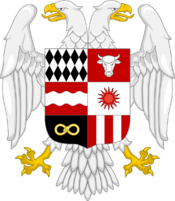Amathian Council Republic: Difference between revisions
No edit summary |
No edit summary |
||
| Line 29: | Line 29: | ||
|event5 = | |event5 = | ||
|date_event5 = | |date_event5 = | ||
|event6 = | |event6 = [[Thistle Uprising (Amathia)|Thistle Uprising]] | ||
|date_event6 = | |date_event6 = 30 November 1958 | ||
|event_pre = Amathian Civil War | |event_pre = Amathian Civil War | ||
|date_pre = 1935-1936 | |date_pre = 1935-1936 | ||
Revision as of 22:02, 3 April 2021
This article is incomplete because it is pending further input from participants, or it is a work-in-progress by one author. Please comment on this article's talk page to share your input, comments and questions. Note: To contribute to this article, you may need to seek help from the author(s) of this page. |
Amathian Council Republic Ⱃⰵⱂⱆⰱⰾⰹⰽⰰ Ⱇⱆⰻⱁⰴⰵⰾⱁⱃ Ⰰⰿⰰⱚⰵ Republica Fujodelor Amathe | |||||||||
|---|---|---|---|---|---|---|---|---|---|
| 1935–1959 | |||||||||
| Motto: "Virtus per Unitatem!" "Ⰲⰹⱃⰹⱅⱆⱄ ⱂⰵⱃ Ⱆⱀⰹⱅⰰⱅⰵⰿ!" "Strength through Unity!" | |||||||||
| Anthem: March of the Workers | |||||||||
| Capital | East Arciluco | ||||||||
| Common languages | Amathian | ||||||||
| Religion | State Atheism | ||||||||
| Demonym(s) | Amathian | ||||||||
| Government | Unitary council republic | ||||||||
| Premier of the State Council | |||||||||
• 1935-1955 | Maria Arzelean | ||||||||
| Legislature | Great National Council | ||||||||
| Historical era | Great Game | ||||||||
• Amathian Civil War | 1935-1936 | ||||||||
• Established | 23 August 1935 | ||||||||
| 30 November 1958 | |||||||||
• Disestablished | 24 May 1959 | ||||||||
• Establishment of the Amathian Equalist Republic | 25 May 1959 | ||||||||
| Currency | Libro (Ⰾ) | ||||||||
| |||||||||
| |||||||||
The Amathian Council Republic, literally the Republic of Amathian Councils (Amathian: Ⱃⰵⱂⱆⰱⰾⰹⰽⰰ Ⱇⱆⰻⱁⰴⰵⰾⱁⱃ Ⰰⰿⰰⱚⰵ, tr. Republica Fujodelor Amathe) was the official name of the Councilist Amathian regime from 1935 to 1958. It was proclaimed following the victory of a left-wing rebel coalition in the Amathian Civil War in early 1936 following Amathia's defeat in the Great War. The new republic was attempting to follow the Kirenian model, and describing itself as a "council republic of workers and peasants". It initially claimed all of the territories of the former Kingdom of Amathia, but it initially only controlled territories in western Amathia, being forced to collaborate with the Soravian occupation forces, and only being recognized internationally by Kirenia and Soravia. The rapid international isolation of Etruria and widespread Amathian opposition to the Etrurian occupation of eastern Amathia however helped its legitimacy both internally and externally, and the Council Republic was recognized as the sole Amathian state following the end of the Solarian War, during which it had fought against Etruria.
The Treaty of - and the Community of Nations confirmed that recognition, and Amathia attempted to align itself with Kirenia and other socialist states, but the continued presence of Soravian occupation forces in West Arciluco remained a constant issue that damaged the popularity of the new regime and led to a continued Soravian influence in the country. Politically, the new republic allowed the existence of varied left-wing factions as long as they were not deemed counterrevolutionary, with the Front of Equality and the Amathian Section of the Workers' Internationale as the two largest movements. The more violent and prolonged establishment of the republic in comparison to other socialist states however led to an increased role in the state of the Amathian People's Army, including the participation of army representatives in councils. Attempts by Amathian internationalists to overturn this following the stabilization of the new state led to rising tensions between the government and the military, while the Equalists adopted a more firmly pro-military stance.
Economically, the first decade after the war was difficult, but the wavering of the war reparations that Amathia would have otherwise had to pay to Etruria, combined with Kiernian and Soravian economic support allowed the councilist government to begin a series of reforms, ranging from land redistribution to industrialization and central planning. The reforms however led to an even deeper fracturing of the political scene, with the Amathian Section breaking into several different factions. This allowed the Equalists, with military support, to gain a majority in most councils, and to use that majority in order to attempt to strengthen their rule. Invoking counterrevolutionary and reactionary dangers, the Equalists started to suspend basic freedoms and gained control of the secret police. This increased authoritarianism scared the other Amathian political factions, who secretly appealed to Kirenia for help. Attempting to protect the Kirenian influence and the councilist system of government, and with the support of the widespread anti-Equalist dissatisfaction among the Amathian population, the opposition launched the Thistle Uprising in late 1958. Initially successful, the uprising was ultimately brutally suppressed by the Equalists with the help of the Soravian military units from West Arciluco.
The Equalist victory in the uprising directly led to the end of the Council Republic, as the Equalists banned some factions and reorganized the political field, gaining complete control and proclaiming the Amathian Equalist Republic in early 1959.


